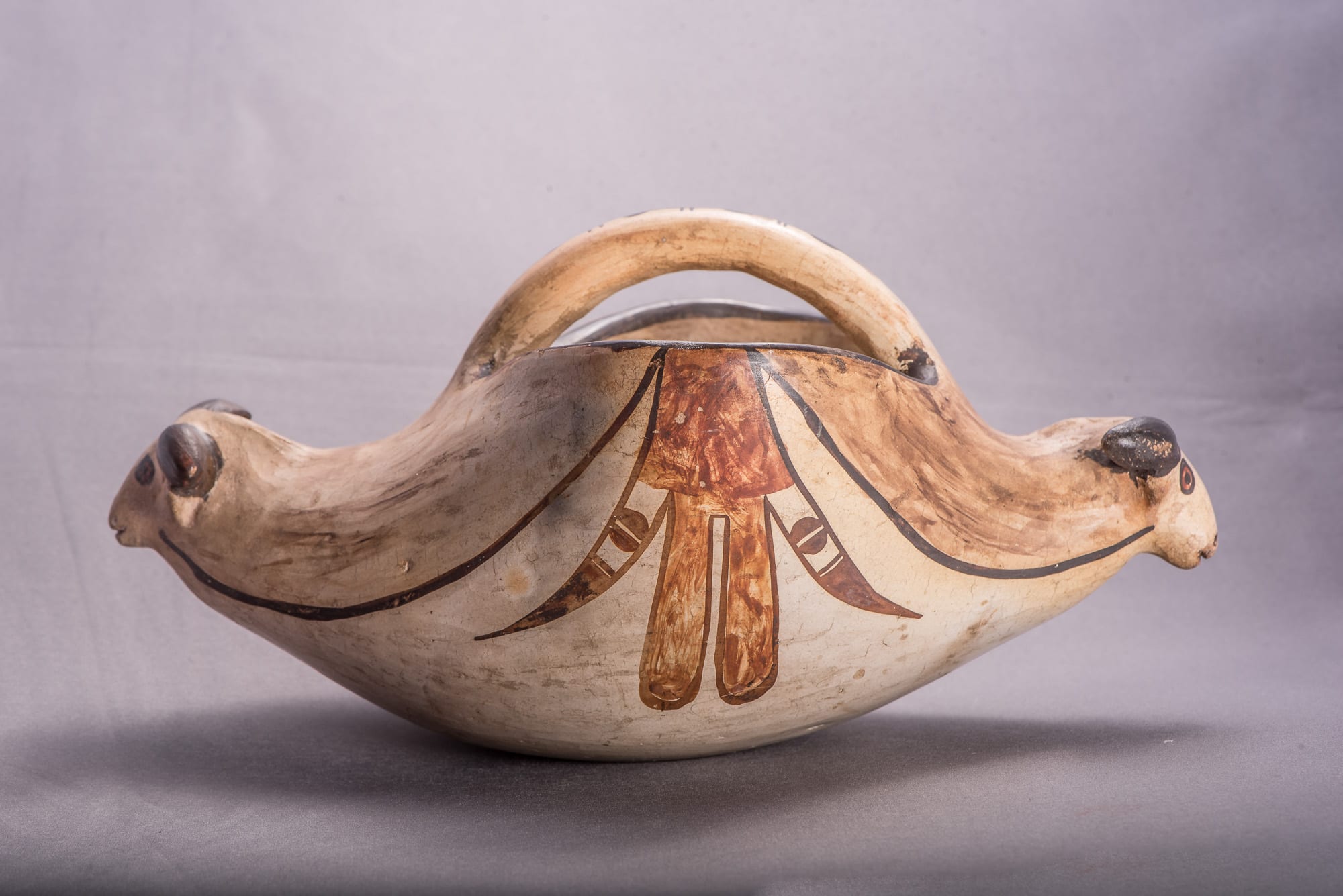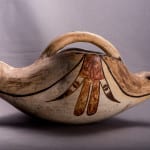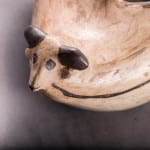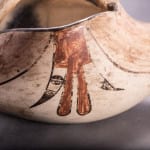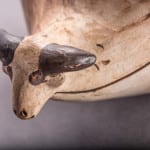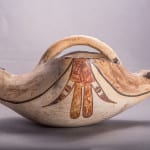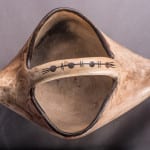5.063” h (including about 0.9” of handle above the rim) X
6.0” w X 10.125” long including the two mountain sheep heads,
one short-necked head is about 1.75” long
the other, longer-necked head is about 2.5” long
The form of this bowl is “exocentric,” different than expected of Hopi or Hopi/Tewa pottery shapes. It dates from about the period that Nampeyo worked at the Harvey Company’s “Hopi House” at the Grand Canyon and might be defined as tourist “kitsch.”
The bowl is rather thick-walled and while the necks of the mountain sheep (?) are mostly hollow, the heads are solid. As a consequence, the pot is heavier than expected.
I am assuming that Nampeyo made a purse-like pot and then spread it out to form the opening, which is not symmetrical. Ritual vessels with handles are known at Hopi (cf. 1996-01, 1998-14 and 2004-03) and thus this feature is not an unexpected. Similarly, pottery with animal effigy heads is unusual, but not unknown at Hopi (cf. 1999-01). It’s the combinastion of odd shape, handle and heads that qualifies this pot as “excentric.”
A Hopi pipe in the form of a mountain sheep’s head is part of the collection of the Smithsonian (Ethnology 128465; catalog #19294) and was collected at Walpi by Col. James Stevenson in 1885-86.
The form of the Smithsonian head (though not the painting) seems close to identical to the heads on pot 2014-17. Of course I have no idea if Nampeyo ever saw such representations, but the Smithsonian example is evidence that they existed in her culture. (Copies of the Smithsonian catalog entry and photographs on file.)
Pot 2014-17 has a rag-wiped white kaolin clay slip that was stone polished. This gives it a smoother, harder finish than some similarly finished pots (cf 1993-04), but it is still not the careful finish of a pot that Nampeyo intended to present as her best work. The irregular finish supports the idea that this was a tourist piece and Nampeyo was playing around when she made this pot, perhaps both for fun and to see what would sell.
The handle is painted with a 2.5” black line with four black balls drawn on it. On either side of and between the two middle balls are sets of two parallel lines. The balls on the ends f the line have three lines faning out from them; these might represent pathos (prayer feathers) and are also found on Nampeyo’s version of the “bird hanging from sky band” bowl in this collection (1993-04).
Black lines run from both sides of each neck, curving down and them back up to the mid-point of the lip. Above these lines Nampeyo seems to have applied a watered-down brown paint that is blochy and adhered better on one end of the bowl than the other. Perhaps this was meant to represent animal fur.
Emerging from the midpoint of the lip and extending down the side of the pot are a pair of red feathers with rounded ends. Extending off the red base are two curved black and pointed feathers on either side of the red pair. Embeded in an unpainted space in the black feathers is a split cloud element. This configuration of liner blunt-taild feathers flanked by a pair of curved pointed feathers is a classic Nampeyo motif, seen on pots 1988-01, 1996-05, 2002-03 and 2013-03 in this collection.
Usually I determine if a pot is by Nampeyo by looking for six decorative techniques that I believe characterize the work of her Sikyatki Revival period. The excentric nature of this pot precludes such a review. The best that can be said is that the appearance of the feather motif is so characteristic of her work that the pot says “Nampeyo. “ The quality of the paijnting reinforces this conclusion.
In an email on 1/11/15, Ed Wade provided the following additional information:
“As for precedents for your figurative bowl there are effigy forms dating from the Polacca C. period. I know of a wonderful Bear effigy which served as a pouring vessel made by Nampeyo within a private collection. In the photo within my book (Wade and Cooke, 2012:132) of Nampeyo sitting amidst a basketry tray filled with miniature canteens there also are a number of effigy headed pieces.
As for dating of your vessel I would put it around 1905 owing to the chalky white kaoline slip which has the appearance of being washed on. Nampeyo was attempting to perfect a hard kaoline slip that could stand up to hard polishing beginning around 1898 but she first began her transition from Polacca slip with this watery application.
The ram or steer effigy heads however are a more commercial derived form and would place the object within the Harvey House period.”
I questioned Ed about the sequence of form and finish mentioned in this email and he responded the next day:
“Actually she (Nampeyo) never followed a lineal progression of either style or technique. The hard slip was typically left for larger pieces or what we would call artworks. She learned with smaller works that often the polish of the slip did not effect sales so you would find the watery slip still used up until 1910 on select pieces.”

